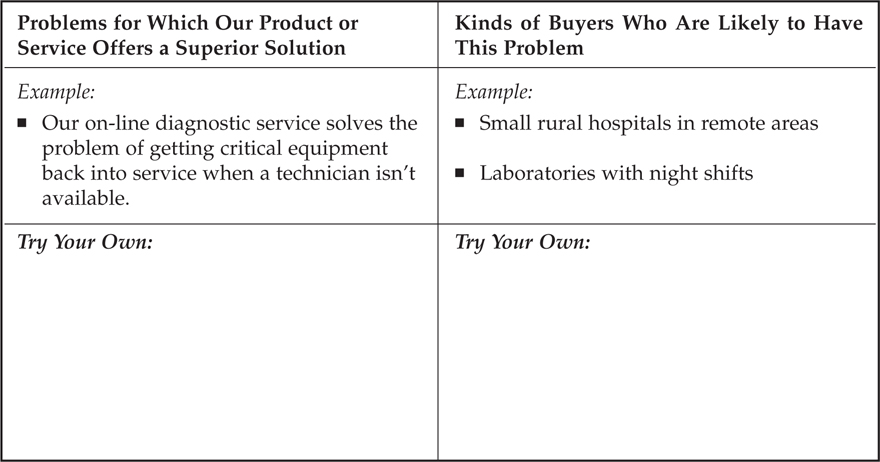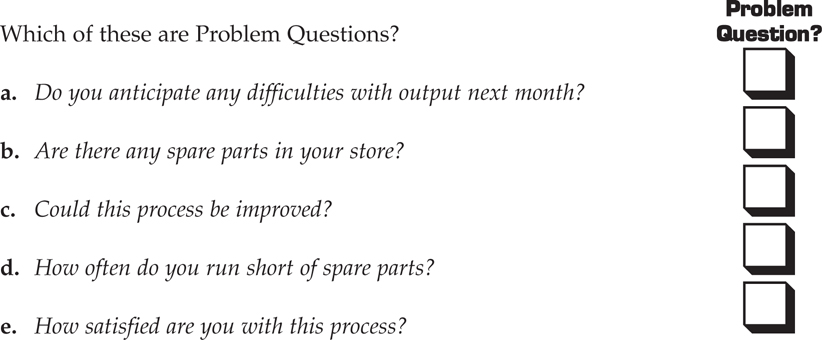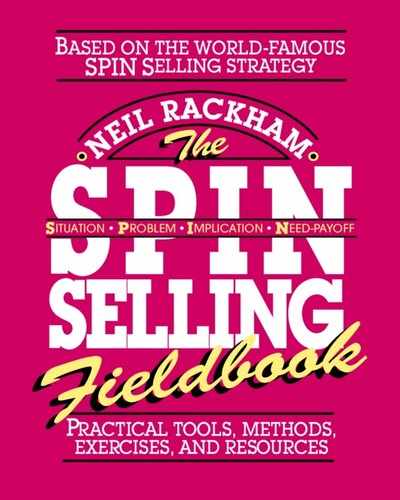8
Problem Questions

Overview
A Problem Question asks about people’s

![]() Problems
Problems
![]() Difficulties, or
Difficulties, or
![]() Dissatisfactions
Dissatisfactions
with an existing situation.
They help you sell because:

![]() People buy only if they have needs.
People buy only if they have needs.
![]() Needs almost always start with a problem or dissatisfaction with the current situation.
Needs almost always start with a problem or dissatisfaction with the current situation.
![]() The clearer and more explicit the need, the more likely the buyer is to buy.
The clearer and more explicit the need, the more likely the buyer is to buy.
To sell effectively, you first have to uncover problems, difficulties, or dissatisfactions—some Implied Needs. That’s how Problem Questions help you. Their purpose is to:
![]() Reveal the buyer’s Implied Needs.
Reveal the buyer’s Implied Needs.
![]() Clarify the buyer’s difficulties and dissatisfactions.
Clarify the buyer’s difficulties and dissatisfactions.
![]() Gain shared understanding of the buyer’s problems.
Gain shared understanding of the buyer’s problems.
Huthwaite’s research shows that Problem Questions are asked more by experienced people and used more in successful calls. And while Problem Questions are linked more strongly to smaller sales, they’re still an essential part of effective probing as the sale grows larger.

![]() You have to uncover problems you can solve, so that you have something useful to offer the customer.
You have to uncover problems you can solve, so that you have something useful to offer the customer.
![]() Problem Questions provide the raw material you need to be able to build the rest of the sale.
Problem Questions provide the raw material you need to be able to build the rest of the sale.
CHECK YOURSELF—PROBLEM QUESTIONS
Before you learn more about using Problem Questions effectively, let’s be sure you’re clear about the difference between Problem Questions and Situation Questions.
Situation or Problem Question?
1. ![]()
2. ![]()
3. ![]()
4. ![]()
5. ![]()
6. ![]()
Answers are on the next page.
PROBLEM QUESTIONS—ANSWERS
1. Situation Question Asking for a fact about the company.
2. Problem Question Asking about a potential difficulty, which might reveal an Implied Need regarding recruiting skilled people.
3. Problem Question Asking about another potential problem, which might reveal another Implied Need regarding turnover.
4. Problem Question Asking about another possible buyer difficulty.
5. Situation Question Just getting details about the buyer’s current situation.
6. Problem Question A more indirect way of asking the buyer to reveal an area of potential dissatisfaction.
If you had any difficulty with any of these questions, remember our definition of a Problem Question:
A Problem Question asks about the problems, difficulties, or dissatisfactions that buyers have with their existing situations.
Later in this chapter, you’ll have an opportunity to practice writing Problem Questions of your own. You’ll also have other chances to check your understanding of how to use Problem Questions effectively.
Using Problem Questions Effectively
After you’ve identified a buyer problem or dissatisfaction by using a Problem Question, it’s important to continue revealing and clarifying until you and your buyer share a thorough understanding of the problem or Implied Need.
Follow-up questions that are used to clarify and understand the buyer’s Implied Need are also called Problem Questions.
Since you want to engage your buyer in a natural way, it’s also important to vary the form of Problem Questions, just as for all the SPIN® questions.
Some useful ways to ask follow-up Problem Questions are Where? When? Who? How often? What happens if/when? You can also ask about dissatisfaction or difficulties by asking indirectly, or by using linking phrases, as these examples show:
![]() How long does it take for your current service provider to respond when you have a breakdown?
How long does it take for your current service provider to respond when you have a breakdown?
![]() How often does your machine break down?
How often does your machine break down?
![]() Where is the breakdown more likely to occur in the process?
Where is the breakdown more likely to occur in the process?
![]() Who usually has to deal with the problem?
Who usually has to deal with the problem?
![]() How satisfied are you with the response time of your current service provider? (Invites the buyer to express any dissatisfaction with the current response time.)
How satisfied are you with the response time of your current service provider? (Invites the buyer to express any dissatisfaction with the current response time.)
![]() Are there specific parts of the system you think could be improved? (Invites the buyer to focus on specific problem areas that might be of concern.)
Are there specific parts of the system you think could be improved? (Invites the buyer to focus on specific problem areas that might be of concern.)
![]() You’ve said that you’re basically satisfied with the current response time to fix breakdowns. Since your business has been growing in the past year, are you worried about what will happen now that the workload is increasing? (Links to a related issue raised by the buyer.)
You’ve said that you’re basically satisfied with the current response time to fix breakdowns. Since your business has been growing in the past year, are you worried about what will happen now that the workload is increasing? (Links to a related issue raised by the buyer.)
Could Problem Questions Turn off the Buyer?
Inexperienced people usually find it easier to ask more Situation Questions than Problem Questions, because they’re concerned that they’ll seem intrusive or negative and might antagonize buyers by asking about dissatisfaction.
But what Huthwaite’s research found was that asking too many Situation Questions was more likely to irritate buyers. Why do you think they might react this way?
Why might buyers actually prefer you to ask more Problem Questions?
What Buyers Actually Say
Here are two typical buyer comments about calls that have too many Situation Questions and too few Problem Questions:
… boring, and she wasted my time. Maybe the salesperson got something she needed out of the call, but I sure didn’t.
The salesperson spent too much time asking for facts he could have found in our annual report. I agreed to the meeting because I thought he might be able to help with our staff turnover concerns, but he never followed up below the surface with any of the problems he brought up.
In fact, buyers say that asking Problem Questions actually increased their respect for the person asking the questions, because they focus on understanding the buyer’s needs.
So, When Asking Problem Questions …
![]() Do your homework first. Ask only a few, well focused Situation Questions that will set the context for asking the Problem Questions you need to ask.
Do your homework first. Ask only a few, well focused Situation Questions that will set the context for asking the Problem Questions you need to ask.
![]() Do use variety. Ask Problem Questions directly, indirectly, and through linking phrases.
Do use variety. Ask Problem Questions directly, indirectly, and through linking phrases.
![]() Do follow up. Ask clarifying Problem Questions when your buyer begins to reveal problems, dissatisfactions, or difficulties.
Do follow up. Ask clarifying Problem Questions when your buyer begins to reveal problems, dissatisfactions, or difficulties.
When to ask problem questions and when to avoid them

Knowing WHEN to ask problem questions is important because there are times when these questions may antagonize your buyer.
When to Ask or Not Ask Problem Questions
When to ask or not ask Problem Questions depends on the level of risk involved. In some cases, you will have to ask Problem Questions very carefully or even avoid them until you have established a degree of trust with the customer or client.
There are three high-risk areas where you need to be wary of probing:
![]() Sensitive areas—where the buyer has a high personal or emotional involvement, such as organizational politics, interdepartmental conflict, and public controversies.
Sensitive areas—where the buyer has a high personal or emotional involvement, such as organizational politics, interdepartmental conflict, and public controversies.
![]() Recent major decisions—where probing may be seen as presumptuous or critical, and where your questions might build resistance to using your product or service, even if the buyer’s decision was clearly a bad one.
Recent major decisions—where probing may be seen as presumptuous or critical, and where your questions might build resistance to using your product or service, even if the buyer’s decision was clearly a bad one.
![]() Your own product or service—where the buyer already uses your product or service and asking Problem Questions might create dissatisfaction. (Even if you can offer a superior alternative, be extremely careful to ask Problem Questions only in an area where you can provide additional capability that the competition cannot offer.)
Your own product or service—where the buyer already uses your product or service and asking Problem Questions might create dissatisfaction. (Even if you can offer a superior alternative, be extremely careful to ask Problem Questions only in an area where you can provide additional capability that the competition cannot offer.)
There are also three low-risk areas where Problem Questions should be used freely to uncover and clarify Implied Needs:
![]() Early in the selling cycle—after you’ve established enough background to set a context and developed enough trust to discuss the buyer’s problems.
Early in the selling cycle—after you’ve established enough background to set a context and developed enough trust to discuss the buyer’s problems.
![]() In significant areas—which might be important to the buyer. The problem has to be important enough so that you can develop the Implied Need into an Explicit Need—a strong desire for a solution.
In significant areas—which might be important to the buyer. The problem has to be important enough so that you can develop the Implied Need into an Explicit Need—a strong desire for a solution.
![]() Where you can offer a solution—since the purpose of asking Problem Questions is to reveal difficulties and dissatisfactions your product or service can resolve.
Where you can offer a solution—since the purpose of asking Problem Questions is to reveal difficulties and dissatisfactions your product or service can resolve.
CHECK YOURSELF—PROBLEM QUESTIONS AND RISK
Now you have a chance to decide when to ask or not ask Problem Questions. Check off which of the following situations would be high-risk and which would be low-risk for you to ask Problem Questions?

1. 
2. 
3. 
4. 
5. 
6. 
Answers are on the next page.
PROBLEM QUESTIONS AND RISK—ANSWERS
1. High-risk The decision is too recent. The buyer is likely to defend the competitor even if real problems exist at this early stage. Asking Problem Questions could create antagonism. After all, nobody likes to admit that they have just made a terrible decision.
2. High-risk The value of asking Problem Questions is in helping to develop clear and explicit needs. Once you’ve developed these needs, Problem Questions could raise doubts in the buyer’s mind or reopen inappropriate issues. So avoid Problem Questions late in the sale.
3. Low-risk Asking Problem Questions uncovers areas of dissatisfaction that you can develop into explicit needs. Of course, a buyer who is really happy with a competitor has no problems for you to develop. If so, the sooner you can find that out, the less time you will both waste.
4. Low-risk This is the ideal time to ask Problem Questions, right after you’ve established details of the buyer’s situation. Having Problem Questions flow naturally from your Situation Questions is best, of course, and that occurs both smoothly and automatically with experienced, successful sellers. Meanwhile, Problem Questions give you the best potential for uncovering Implied Needs.
5. High-risk If you ask Problem Questions, you may create dissatisfaction with your own product. Only ask Problem Questions if you’re offering something different to the buyer.
6. Low-risk This is the very best area for Problem Questions. The more you can build up the seriousness and size of the problems, the more anxious the buyer will be to buy your solution.
Assessing High Risks in Your Own Cases
Can you think of an existing or potential buyer situation you face that has high risks for asking Problem Questions? Describe it briefly in the first space. Then ask yourself the related questions, and record your answers as you think through each question.
Putting Problem Questions to Work
Successful use of Problem Questions invites the buyer to state Implied Needs. Remember, Implied Needs provide the raw material for Implication Questions (covered in the next chapter), which are used in large sales to develop the urgency of the buyer’s problem and a strong desire for a solution—which your product or service can potentially provide.
Planning your buyer interactions ahead of time is the best way to put all the SPIN® behaviors to work, both to build your skills and achieve successful results. Now it’s your turn to practice planning Problem Questions for a prospective buyer of your own.
What Problems Do Your Products or Services Solve?
A good way to start planning Problem Questions is by thinking about the problems your products or services solve for a buyer. Try this exercise first; then move on to the next exercise on the following page.

Now you’re ready to begin putting Problem Questions to work with a buyer of your own, zeroing in on the problems you can best solve with your products or services.
Practice Problem Questions with One of Your Own Buyers
1. Use the planning form on the next page for this exercise. First, select a prospective buyer to practice planning for. Use these criteria to pick a good candidate:
![]() You’ll be meeting with the prospect in the next week or two.
You’ll be meeting with the prospect in the next week or two.
![]() You’ve done some homework to learn basic facts about the buyer.
You’ve done some homework to learn basic facts about the buyer.
![]() There’s a good chance the prospective buyer has one of the problems you listed in the previous exercise.
There’s a good chance the prospective buyer has one of the problems you listed in the previous exercise.
![]() It will be your first or second face-to-face meeting.
It will be your first or second face-to-face meeting.
![]() There will be little risk involved in trying out a new behavior (Problem Questions) with this buyer.
There will be little risk involved in trying out a new behavior (Problem Questions) with this buyer.
2. Write the Buyer Name and Meeting Date at the top of the planning form.
3. Identify as many Potential Problem Areas as possible where the buyer could have concerns, difficulties, or dissatisfactions that your product or service could resolve. Write your ideas in the planning form. (Quantity counts!)
![]() First list the problems you came up with in the previous exercise that are likely to apply to this prospective customer.
First list the problems you came up with in the previous exercise that are likely to apply to this prospective customer.
![]() Add any other problems that may be unique to this prospective buyer and that your product or service could resolve.
Add any other problems that may be unique to this prospective buyer and that your product or service could resolve.
4. Develop a variety of Problem Questions to ask—as many as possible.
![]() Write out different variations of Problem Questions.
Write out different variations of Problem Questions.
![]() Use direct and indirect Problem Questions.
Use direct and indirect Problem Questions.
5. Use the Problem Questions you develop!
![]() Rehearse your questions ahead of the meeting, if possible, with a colleague.
Rehearse your questions ahead of the meeting, if possible, with a colleague.
![]() Actually ask the buyer the Problem Questions you developed when you meet.
Actually ask the buyer the Problem Questions you developed when you meet.
There’s nothing wrong with taking your list of Problem Questions into the meeting with you. Very successful salespeople use a question list to prompt themselves during discussions with buyers.
PLAN YOUR OWN PROBLEM QUESTIONS
Customer or Client Name ___________________________ Meeting Date __________
Beyond the Basics—Problem Questions
Use Follow-up Problem Questions
One important use of Problem Questions is clarifying the problems that your buyer identifies. Follow-up Problem Questions clarify specific difficulties or concerns and help you focus your needs development efforts where they’ll be more likely to result in a sale.
The purpose of the exercise in Chapter 6, “Working Backward to the Problem,” was to show you the importance of looking for the specific problems (Implied Needs) that lead to the Explicit Need you can meet with your superior product or service. Follow-up Problem Questions, such as the following examples, can help you clarify and understand the Implied Needs you should focus on:
I want to be sure I’m clear about which kind of [problem] you’re having; could you tell me more about [problem]?
How often does [problem] happen? Do you have that trouble all the time or only once in a while?
It sounds like you’re quite concerned about [problem]. Is that the issue that concerns you most?
The most powerful of all the follow-up Problem Questions you can ask is the magic word—why? When a buyer says, “I’m not satisfied with our current whatsit …,” an average seller is impatient to begin talking solutions. But an expert seller asks “why not?” or “why is that a problem?” The effective seller is careful to clarify the problem before asking Implication Questions. Asking why can help you:
![]() Better understand the reasons behind the buyer’s dissatisfaction.
Better understand the reasons behind the buyer’s dissatisfaction.
![]() Uncover related problems or effects.
Uncover related problems or effects.
Then you can use what you learn about the problem to ask powerful Implication Questions or focus on a selected problem that your solution can best solve.
Uncover Several Problems before Delving into Implications
Successful sellers uncover several problems before they start asking Implication Questions. Why? A smart seller wants to have several problem avenues to pursue if any individual implication proves to be a dead end. Let’s see what happens when a buyer deflects an implication that the seller raises before first uncovering other problems:
SELLER You mentioned that you’ve been having a problem with the facing alloy you use. Can you tell me more about that? [A good follow-up Problem Question]
BUYER Yes, the bonding often loosens when it goes through the buffer.
SELLER So, does that mean you lose production time repairing the bond before final assembly? [The seller asks an Implication Question, hoping to develop the seriousness of the existing bonding problem.]
BUYER No, that’s not really an issue, because the stamping press resets the bond before final assembly.
SELLER Oh … [Oops, nowhere to go.]
In the next example, the seller uncovers several problems before asking the first Implication Question, so he can develop a different need if the buyer deflects the first one:
SELLER You mentioned that you’ve been having a problem with the facing alloy you use. Can you tell me more about that? [A good follow-up Problem Question]
BUYER Yes, the bonding often loosens when it goes through the buffer.
SELLER Are you having any other difficulties with the facing alloy?
BUYER Yes, it loses its tensile strength when it goes through polishing. So we’ve had to scrap or rework about 10 percent of the pieces. And customer complaints have been increasing.
SELLER So does that mean you lose production time repairing the bond before final assembly? [The seller asks the same Implication Question to develop the seriousness of the existing bonding problem.]
BUYER No, that’s not really an issue, because the stamping press resets the bond before final assembly.
SELLER Okay … could we go back to the scrap problem? [Or the rework problem or the complaint problem] Has the 10 percent scrap rate been squeezing your margins?
Try Seeing the Problem from Different Functional Perspectives
In complex sales, it’s important to explore and understand a problem from more than just one perspective. This can build the seriousness of the problem. A good way to start is by asking how your contact thinks the problem might be viewed by someone in another function. For example, “I can see why that would be a problem for you in manufacturing. How might that concern marketing/product development/finance?” You may be able to turn the discussion into an invitation to meet with the other decision maker.
PROBLEM QUESTIONS—SUMMARY CHECK
1. 
2. 
3. 
4. 
Answers are on the next page.
SUMMARY CHECK—ANSWERS
1. (b): the purpose of Problem Questions is to reveal Implied Needs.
2. (a), (c), (d), and (e) are Problem Questions.
3. (b) and (c) are high-risk for asking Problem Questions.
4. (a) and (c) are effective ways to introduce Problem Questions smoothly.
